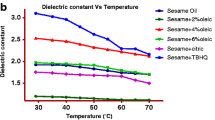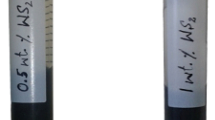Abstract
Thermal and flow properties of unrefined oils from the heads of red or pink salmon were evaluated. Major thermal degradation of the salmon oils occurred between 200 and 450°C. Red and pink salmon oils were completely decomposed at 533 and 668°C, respectively. The phase transition of salmon oils occurred over a wide range of temperatures. The melting points of −69.6 to −0.36°C and −64.7 to 20.8°C were observed for red and pink salmon oils, respectively. The enthalpy was 40 j/g for red salmon oil and 39 j/g for pink salmon oil. Specific heat capacity ranges of 0.8 to 1.6 and 1.3 to 2.3 j/g/°C were observed for red and pink salmon oils, respectively. Both salmon oils exhibited Newtonian flow behavior. Red salmon oil required higher magnitudes of energy (kj·mol−1) to flow than pink salmon oil. The viscosity of salmon oils was temperature-dependent and could be predicted by the Arrhenius equation.
Similar content being viewed by others
References
Wesolowski, M., and J. Erecinska, Thermal Analysis in Quality Assessment of Rapeseed Oils, Thermochim. Acta 323:137–143 (1998).
Sathivel, S., W. Prinyawiwatkul, I.I. Negulescu, J.M. King, and B.F.A. Basnayake Thermal Degradation of Fatty Acids and Catfish and Menhaden Oils at Different Purification Steps, J. Am. Oil Chem. Soc. 80:1131–1134 (2003).
Hassel, R.L., Thermal Analysis: An Alternative Method of Measuring Oil Stability, J. Am. Chem. Soc. 53:179–181 (1976).
Gearhart, W.M., B.N. Stuckey, and J.J. Austin, Comparison of Methods for Testing the Stability of Fats and Oils, and of Foods Containing Them, 34:427–430 (1957).
Buhri, A.B., and R.P. Singh, Thermal Properties Measurements of Fried Foods Using Differential Scanning Calorimeter, in Developments in Food Engineering, edited by T. Yano, R. Matsumoto, and K. Nakamura, Blackie A&P, Glasgow, 1994, pp. 201–203.
Kaisersberger, E., DSC Investigations of Thermal Characterization of Edible Fats and Oils, Thermochim. Acta 151:83–90 (1989).
Ritter, B., J. Schulte, and E. Schulte, Detection of Coating Waxes on Apples by Differential Scanning Calorimetry, Eur. Food Res. Technol. 212:603–607 (2001).
Iannotta, N., C. Oliviero, G.A. Ranieri, and N. Uccella, Determination of the Oil Content in Olives by the DSC Technique, Eur. Food Res. Technol. 212:240–243 (2001).
Lai, L.S., and S.J. Chao, A DSC Study on the Gel-Sol Transition of a Starch and Hsian-tsao Leaf Gum Mixed System, J. Agric. Food Chem. 48:3267–3274 (2000).
Sherman, P., Industrial Rheology with Particular Reference to Foods, Pharmaceuticals and Cosmetics, Academic Press, London, 1970.
Wiedermann, L.H., Degumming, Refining and Bleaching Soybean Oil, J. Am. Chem. Soc. 58:159–166 (1981).
Sathivel, S., W. Prinyawiwatkul, I.I. Negulescu, J.M. King, and B.F.A. Basnayake, Effects of Purification Process on the Rheological Properties of Catfish Oil, 80:829–832 (2003).
AOAC, Official Methods of Analysis, 16th edn., Association of Official Analytical Chemists, Arlington, VA, 1995.
Rao, M.A., Rheological of Fluids and Semisolids: Principles and Applications, An Publishers, Gaitherburg, MD, 1999.
SAS, SAS/STAT User's Guide, version 8.2, SAS Institute, Cary, NC, 2002.
Sathivel, S., W. Prinyawiwatkul, J.M. King, C.C. Grimm, and S. Lloyd, Oil Production from Catfish Viscera, J. Am. Chem. Soc. 80:377–382 (2003).
Sathivel, S., Production, Process Design and Quality Characterization of Catfish Visceral Oil, Ph.D. Dissertation, Louisiana State University, Baton Rouge, 2001.
Zhao, L., and S.H. Yalkowsky, A Combined Group Contribution and Molecular Geometry Approach for Predicting Melting Points of Aliphatic Compounds, Ind. Eng. Chem. Res. 38:3581–3584 (1999).
Ewell, R.H. The Reaction Rate Theory of Viscosity and Some of Its Applications, J. Appl. Physics 9:252 (1938).
Author information
Authors and Affiliations
Corresponding author
About this article
Cite this article
Sathivel, S. Thermal and flow properties of oils from salmon heads. J Amer Oil Chem Soc 82, 147–152 (2005). https://doi.org/10.1007/s11746-005-1057-6
Accepted:
Issue Date:
DOI: https://doi.org/10.1007/s11746-005-1057-6




